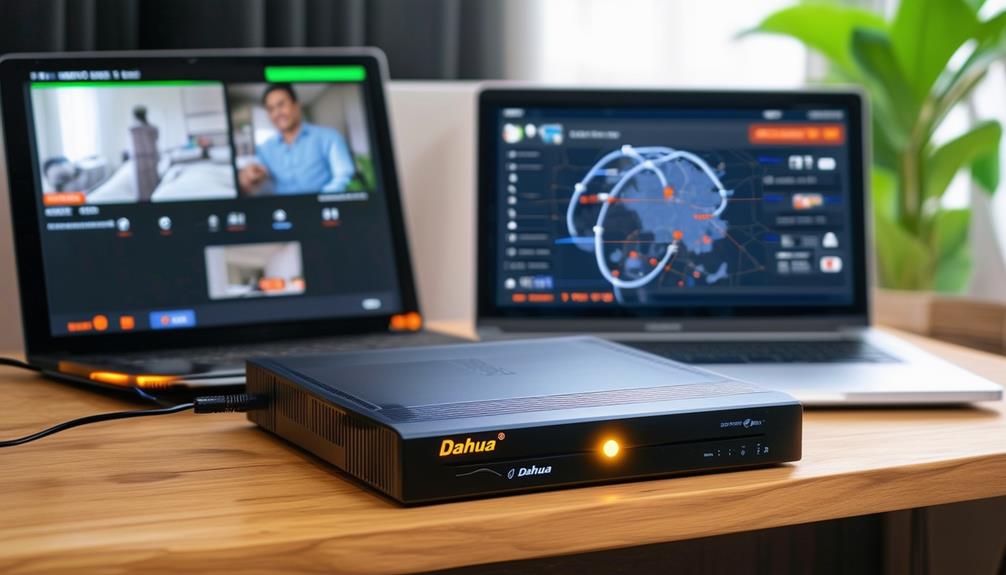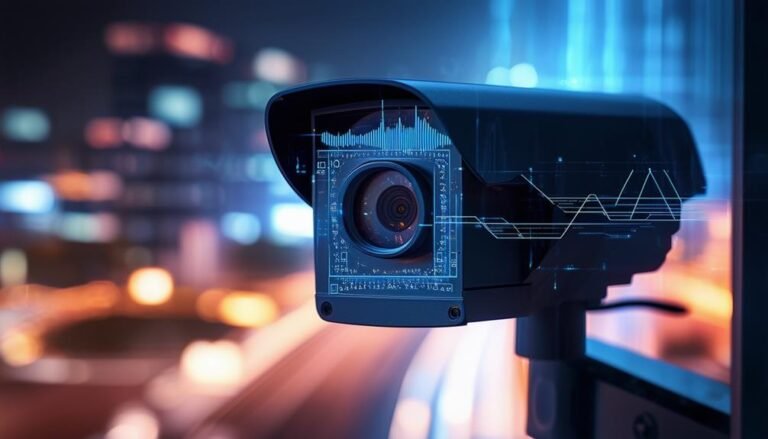To connect your Dahua DVR to the internet, start by deciding if you want a wired or wireless connection. For wired, plug an Ethernet cable from the DVR’s port to your router. For wireless, access the network settings on the DVR, scan for available networks, and enter the Wi-Fi password. Next, configure the DVR’s network settings, ensuring you assign an IP address and DNS settings. After that, test the connection by pinging the DVR’s IP or accessing its web interface. Once connected, you’ll be set for remote viewing and monitoring. Keep exploring to discover further useful tips!
Understanding Your Dahua DVR
When you first set up your Dahua DVR, it’s important to get familiar with its features and functions. This understanding lays the groundwork for a seamless connection to the internet, empowering you to monitor your space without limitations. Your DVR isn’t just a recording device; it’s a powerful tool that gives you the freedom to access your surveillance footage from anywhere.
Start by exploring the main interface. You’ll find options for live viewing, playback, and settings. Each button is designed to enhance your security experience, allowing you to customize how you want your system to operate. Pay special attention to the settings menu, where you can adjust resolution, frame rates, and recording schedules to fit your lifestyle.
Next, familiarize yourself with the connectivity options. The DVR typically supports both wired and wireless connections, giving you the flexibility to choose what works best for your setup. Understanding these options means you can optimize your network for the best performance, ensuring you’ll never miss a moment.
Also, take note of the user manual. It’s a valuable resource that provides detailed information on each feature. By knowing your DVR inside and out, you can make informed decisions on how to effectively use it.
Ultimately, mastering your Dahua DVR means you’re one step closer to achieving peace of mind, knowing you’re in control of your security system. Enjoy the freedom that comes with full access to your surveillance world!
Checking Internet Requirements
Before diving into the setup, it’s important to check your internet requirements to guarantee smooth operation of your Dahua DVR. Having the right internet setup not only enhances performance but also ensures you can access your cameras remotely without frustration. Here are some key aspects to keep in mind:
- Bandwidth: Verify you have sufficient upload speed, as this is essential for streaming video feeds. A minimum of 1 Mbps is recommended, but higher speeds are better for multiple cameras.
- Data Caps: Check if your internet plan has data caps. Streaming video can consume significant bandwidth, so unlimited plans are preferable.
- Router Compatibility: Make sure your router supports the right protocols, such as DHCP, which is crucial for assigning IP addresses to your DVR.
- Network Stability: A stable connection is key. If your internet drops frequently, you’ll face interruptions in your video feed, which you definitely want to avoid.
- Security: Ensure your network is secure. Use strong passwords and think about a separate network for your DVR to keep it safe from potential threats.
Connecting DVR to Router
Now that you’ve checked your internet requirements, it’s time to connect your Dahua DVR to your router. You can choose between a wired connection setup for stable performance or a wireless connection if you prefer flexibility. Let’s go over the steps for each method so you can get your system online.
Wired Connection Setup
Connecting your Dahua DVR to a router using a wired connection is a straightforward process that can greatly enhance your system’s reliability. By opting for a wired setup, you guarantee a stable and consistent internet connection, freeing you from interruptions that can occur with wireless connections.
Here’s how to get started:
- Gather your equipment: You’ll need an Ethernet cable and a router.
- Locate the Ethernet port: Find the Ethernet port on your DVR, usually situated at the back.
- Connect the cable: Plug one end of the Ethernet cable into the DVR and the other into an available port on your router.
- Power on your devices: Make sure both the DVR and router are powered on.
- Access network settings: On your DVR, navigate to the network settings to configure the connection.
Once you’ve completed these steps, you should enjoy a seamless experience with your Dahua DVR connected directly to the internet. This wired connection not only boosts your system’s performance but also gives you peace of mind knowing your surveillance is always online.
Wireless Connection Setup
For those who prefer a wireless setup, connecting your Dahua DVR to your router can provide flexibility and ease of installation. First, make certain your DVR is compatible with Wi-Fi. Once confirmed, access the DVR’s menu using your remote or the front panel. Navigate to the network settings, and choose the Wi-Fi option.
Next, scan for available networks. You should see a list of Wi-Fi networks in range. Select your network and enter the Wi-Fi password when prompted. Double-check for accuracy, as a small mistake can prevent a successful connection. Once you’ve input the password, save the settings and reboot the DVR.
After rebooting, go back to the network settings menu to verify the connection. If everything’s set up correctly, you should see your DVR connected to the internet. This wireless connection allows you to monitor your cameras without being tethered to a cable, giving you freedom in where you place your DVR.
Lastly, remember to periodically check your connection status to confirm it’s stable. Enjoy the flexibility of your wireless setup and the peace of mind it brings!
Configuring Network Settings
Configuring network settings on your Dahua DVR is essential for ensuring seamless access to your surveillance system over the internet. When you get the network settings right, you’ll be able to monitor your property from anywhere, providing you that peace of mind you deserve. Here’s how to set it up:
- Access the Menu: Use the remote or mouse to navigate to the main menu of your DVR.
- Select Network Settings: Look for the network configuration option, typically found under the ‘Settings’ or ‘Configuration’ menu.
- Set IP Address: Choose whether to use DHCP (automatic IP) or assign a static IP address. A static IP is often more reliable for remote access.
- Configure Subnet Mask and Gateway: Enter the appropriate subnet mask and default gateway settings. This info is critical for connecting your DVR to your router.
- DNS Settings: Don’t forget to enter your DNS server address, which can usually be found through your internet provider or you can use a public DNS like Google’s (8.8.8.8).
Once you’ve adjusted these settings, save and reboot your DVR. After that, test your connection by accessing the DVR from a remote location. This setup will empower you to monitor your space freely, without the constraints of being physically present. Enjoy the flexibility and security that comes with having your surveillance system online!
Setting Up DDNS
After confirming your Dahua DVR is properly connected to the internet, setting up Dynamic Domain Name System (DDNS) is the next step to enhance remote access. DDNS allows you to access your DVR using a domain name instead of an IP address, making it easier to connect remotely. Here’s how you can set it up:
1. Choose a DDNS Provider: Select a reliable DDNS service provider. Some popular options include No-IP, DynDNS, and DuckDNS.
2. Create an Account: Sign up for an account with your chosen provider and follow their instructions to create a unique domain name.
3. Configure DDNS on Your DVR:
- Access your DVR’s settings.
- Navigate to the DDNS section.
- Enter your DDNS provider’s details, including your domain name, username, and password.
4. Save Settings: After entering all required information, save your settings and reboot your DVR if necessary.
Here’s a quick overview of the steps:
| Step | Action | Notes |
|---|---|---|
| Choose a DDNS Provider | Research and pick a reliable service | Look for features and pricing |
| Create an Account | Sign up and create a unique domain name | Make sure it’s memorable |
| Configure on DVR | Input provider details in the DVR settings | Confirm accuracy to avoid issues |
With DDNS set up, you’re free to access your Dahua DVR from anywhere in the world. Enjoy the peace of mind that comes with knowing you can keep an eye on things, no matter where you are!
Testing Internet Connection
Occasionally, testing your Dahua DVR’s internet connection is essential to verify it’s functioning correctly. You want to ascertain that your system can communicate with the internet, allowing for smooth operation and remote access when you need it. Here are a few steps you can take to test your connection effectively:
- Check the LED indicators: Look for the network status lights on your DVR. A solid green light usually indicates a good connection.
- Ping the DVR: Use a computer on the same network to ping the DVR’s IP address. If you get a response, your DVR is connected to the network.
- Access the DVR’s web interface: Enter the DVR’s IP address in your web browser. If it loads, your connection is solid.
- Run a speed test: Use an online speed test tool to check your internet speed. Low speeds may affect your DVR’s performance.
- Check for firmware updates: Sometimes, outdated firmware can cause connection issues. Make sure your DVR is running the latest version.
Accessing Remote Viewing
Once you’ve confirmed your Dahua DVR has a stable internet connection, you’re ready to set up remote viewing. It’s all about accessing your security system from anywhere, giving you the freedom to keep an eye on things even when you’re not at home. First, download the Dahua app, either the DMSS or the gDMSS, from your device’s app store. This app will be your gateway to remote monitoring.
Once installed, open the app and create an account if you haven’t already. After logging in, tap the “+” icon to add your DVR. You’ll need to enter the DVR’s serial number, which you can find on the device or in the settings menu. Make sure you input the correct IP address, which is vital for connecting to your DVR over the internet.
If you’ve set up a port forwarding in your router, use that external port number as well. This step is essential; it allows your app to communicate effectively with your DVR. Once you’ve entered all the necessary details, save the settings.
Now, you should see your DVR listed in the app. Tap on it, and after a moment, you’ll gain access to live feeds from your cameras. You can view recordings, adjust settings, and even receive alerts—all from the convenience of your smartphone or tablet. Enjoy the peace of mind that comes with knowing you can monitor your property anytime, anywhere!
Troubleshooting Common Issues
When you’re trying to connect your Dahua DVR to the internet, you might run into a few common issues. These can include network configuration problems, firmware update errors, and IP address conflicts. Let’s tackle these challenges one by one to get your system up and running smoothly.
Network Configuration Problems
Network configuration problems can be frustrating, especially when you’re keen to monitor your security footage remotely. If you’re having trouble connecting your Dahua DVR to the internet, don’t worry; you’re not alone. Here are some common issues and tips to resolve them:
- Incorrect IP Address: Make sure the DVR’s IP address is within your network range.
- Subnet Mask Issues: Check that the subnet mask matches your router’s settings.
- Gateway Configuration: Verify that the default gateway is set to your router’s IP address.
- Firewall Settings: Sometimes, firewalls block connections. Adjust your router’s settings as needed.
- DNS Configuration: If you’re having trouble with domain names, try entering a public DNS like Google’s (8.8.8.8).
Firmware Update Errors
Updating your Dahua DVR’s firmware can sometimes run into bumps in the road, preventing a smooth installation. If you encounter issues during the update process, don’t panic! You can troubleshoot these firmware update errors with a few straightforward steps.
First, verify you’re using the correct firmware version for your specific model. Using the wrong version can lead to failed updates. Next, check your internet connection. A stable connection is essential for downloading the firmware and making sure the update process runs smoothly.
If the update fails, try rebooting your DVR and router. Sometimes, a simple reset can clear minor glitches that might be hindering the update. If you’re still having trouble, consider re-downloading the firmware file. Corrupted files can lead to errors during installation, so it’s always worth verifying the integrity of the downloaded file.
Lastly, if the update continues to fail, consult Dahua’s support forums or contact their customer service. They can provide guidance specific to your issue, making certain you get the most out of your device. With a little patience, you’ll be able to enjoy all the benefits of the latest firmware.
IP Address Conflicts
Sometimes, you might run into issues with your Dahua DVR due to IP address conflicts. This happens when two devices on the same network are assigned the same IP address, causing confusion and connection problems. Thankfully, troubleshooting these conflicts can be straightforward. Here are some steps you can take to resolve the issue:
- Check your DVR’s IP address: Make sure it’s unique within your network.
- Review your router settings: Look for devices that might have overlapping IP addresses.
- Assign a static IP: Consider setting a static IP for your DVR, ensuring it doesn’t change.
- Reboot devices: Restart your DVR and router to refresh the network connections.
- Use DHCP reservations: Configure your router to reserve an IP address for your DVR, preventing future conflicts.
Enhancing Security Features
To fortify your security setup, enhancing the features of your Dahua DVR is essential. By doing so, you’ll not only improve surveillance capabilities but also increase your peace of mind. Start by enabling motion detection and setting up alerts. This way, you’ll be instantly notified of any unusual activities, allowing you to take action when needed.
Next, consider adjusting your video quality settings. Higher resolution can provide clearer images, making it easier to identify faces or license plates. Additionally, you can schedule recordings based on specific times when you’re away or when activity is more likely, conserving storage space while still capturing vital footage.
Lastly, don’t forget to secure your DVR itself. Change default passwords to something unique and strong, and regularly update the firmware to protect against vulnerabilities.
Here’s a quick comparison of security features to enhance on your Dahua DVR:
| Feature | Importance |
|---|---|
| Motion Detection | Immediate alerts |
| High Resolution Video | Clearer identification |
| Scheduled Recordings | Efficient storage usage |
| Password Protection | Prevent unauthorized access |
| Firmware Updates | Security against threats |
Frequently Asked Questions
What Is the Default Username and Password for Dahua DVR?
Ah, the age-old quest for the elusive default username and password for your Dahua DVR. It’s like searching for treasure in a sea of tech jargon! Typically, you’ll find it’s “admin” for both the username and password. But hey, don’t forget to change it afterward; we all love a bit of freedom, right? Free your device from the shackles of default settings and secure your digital domain with your own unique passcode!
Can I Connect Multiple DVRS to One Internet Connection?
Yes, you can connect multiple DVRs to one internet connection. It’s pretty straightforward! Just make certain each DVR has a unique IP address to avoid conflicts. You’ll need a reliable router to handle the traffic, especially if you’re streaming or recording simultaneously. Keep in mind that your internet speed might affect performance, so check your bandwidth to guarantee everything runs smoothly. Enjoy the flexibility of monitoring all your devices from one connection!
How Do I Reset My Dahua DVR to Factory Settings?
Did you know that nearly 70% of security system users don’t know how to reset their devices? If you’re feeling stuck, you can easily reset your Dahua DVR to factory settings. Just locate the reset button on the back, press and hold it for about 10 seconds, and it’ll reboot. This’ll restore your freedom to customize settings according to your needs. It’s that simple—take control and start fresh!
Is Remote Viewing Available on Mobile Devices?
Yes, remote viewing is definitely available on mobile devices! You can use the Dahua app to access your DVR from anywhere, giving you the freedom to monitor your security system on the go. Just make sure your DVR is set up correctly and connected to the internet. Once that’s done, you’ll be able to check live feeds and recorded footage right from your smartphone or tablet, keeping you connected and secure.
What Are the Benefits of Using a Static IP Address?
Imagine sailing on a calm sea, your boat anchored in one spot. That’s what a static IP address offers you; stability. It simplifies remote access, guarantees your devices are always reachable, and can enhance security. You won’t have to chase changing addresses like waves crashing against the shore. Plus, for remote viewing, it makes connecting seamless. With a static IP, you’re free to monitor your system anytime, anywhere, without worries.



